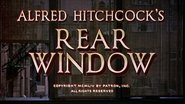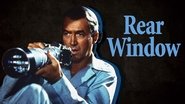Hellen
I like the storyline of this show,it attract me so much
Pluskylang
Great Film overall
Reptileenbu
Did you people see the same film I saw?
Cleveronix
A different way of telling a story
chaz-76862
Wow, this movie was just great.Everything about it was just flawless. The pacing and the story kept me on the edge of my seat for the whole run time. I felt invested in the story and was interested about where it would go next. The acting was superb and helped pushed this film along. I also particularly liked how it didn't tell us everything from the beginning and we had to figure the mystery out along with the actors.In one sentence: "one of the best films ever made".
mge-29659
Alfred Hitchcock's Rear Window is a fantastic example of his ingenuity and vision when creating films. While of course this movie has a great story with meaningful dialogue, the way Hitchcock tells the story is what truly is impressive. The movie starts with a panning shot around the main character's apartment, which reveals that he is a photographer who has broken his leg and is now wheelchair bound. Because of this the entire movie is shot from the perspective of the apartment. The camera never leaves. As a result, many important film techniques were necessary to create a complex story with multiple characters only looking from one spot.
Hitchcock is restricted to using only a few camera angles because the entire movie is shot from in perspective, for example eye-level for shots in the apartment, and then long shots and a few close-ups for things outside the apartment. But even with so few types of camera angles, Hitchcock uses the camera angles to advance the story. For example, every shot from the apartment is a long shot in the beginning, the same way anyone in the apartment would see. These long shots show the basis of what is happening in the scene, but it is difficult to see the details from this angle. but when the main character grabs a pair of binoculars to investigate further, a close is used, showing the viewer exactly what the character would see, and giving them the same amount of detail.
Another technical piece of film that Hitchcock incorporates into the story is the use of light and dark. Early in the film the main character is spying on his suspicious neighbor, and he realizes he can be seen through his window, so he backs into his unlit apartment to stay hidden. This action of hiding in the dark is repeated throughout the film, until the neighbor eventually notices him and make's it to the apartment. Since the main character is crippled, he obviously can't fight. So, he uses the light and dark to his advantage. He turns all the lights off and uses flash bulbs to blind his attacker. Hitchcock uses light and dark as a weapon for the main character, as it's the only way he can defend himself with his condition.
While Hitchcock uses camera tricks to create suspense and intrigue in the film, he mostly uses mise en scene to carefully create every scene and put everything exactly where it should be to perfectly tell the story. Many of the "mysteries" created in the film are crated purely out of the perspective of the main characters. For example, the suspicious neighbor is yelling at his wife, but the shade is down in their window, so neither the characters or the viewers know what's really going on. Or when the neighbor moves his wife's purse form the bedroom to another room, a wall perfectly blocks the neighbor from the main characters point of view. Every object in each scene, and every wall or blockage of something is carefully planned out by Hitchcock to create a sense of suspense and mystery, while just sitting in one spot, away from all the action.
Hitchcock's Rear Window is truly a test of his creativity when directing a film. To be able to tell an interesting and well written story from the perspective of one person who doesn't move the whole movie really shows how good of a director Alfred Hitchcock is. He perfectly incorporates many technical pieces of film such as specific camera angles, right, and placement of subjects within a scene for giving the viewer a similar perspective to the main character, and creating an interesting and well-developed world just from the view of one rear window
axg-83361
Alfred Hitchcock's 1954 film, Rear Window, features a shocking neighborhood murder, only to be uncovered by a peeping wheelchair-bound photographer, L.B Jefferies, and his cover girl girlfriend Lisa Fremont. How we know such details from each character is due to Hitchcock's panning and fantastic sense of mise en scène. At the opening of the film, what is first seen is the window the main character L.B. Jefferies spends his days looking out of. From there, the camera's motion moves as if it were to float about the neighborhood, catching the neighbors, sleeping Jefferies, his shattered camera and a magazine with his girlfriend on it. Without getting too into it, Hitchcock had already planted important information into the viewer's mind without having to achieve the same thing through an extensive amount of dialogue. Very aware of what and how people and objects are placed, he knew precisely what he was doing.
One of the first things the viewer learns about the photographer is that he seems unhappy to be in a relationship with a 'perfect woman', he finds him and Lisa to be incompatible due the fact that the two come from different worlds. Each neighbor featured in a way relates to Jeffries's relationship situation or relationships in general. For example, there was a moment where the shot was focused on Miss Lonelyhearts raising her glass to nobody, and Jefferies did the same. This could because
Not to mention the most obvious aspect of the film, the one vantage point. Hitchcock creatively chose to limit the motion of the camera to the motion of the main character. Doing this, it is impressive how he envisioned and conveyed what he wanted using other camera techniques. For example, he used close ups on several neighbors to shift the focus onto them. In addition, there were several closeups of both Jeffries and Lisa individually and together. The proximity in these shots along with the eye leveled position of the camera play a role in how intimate the viewer gets to the character, including their feelings and emotions. This, I believe creates a more intense feeling when suspense is reached towards the end of the film.
The use of light is also intriguing. Its symbol of clarity and when not present, obscurity. Having this in mind, it is important to mention that whenever the characters had to hide from the gaze of Mr.Thorwald, they would retreat into the darkness. In addition, whenever Lisa came over to talk to Jeffries about the potential murder, she would turn the lights on, begging for him to stop scaring her and talking nonsense. However, when she began to believe him, she stood in the darkness alongside him. Lights were also turned off when Mr. Thorwald found Lisa with his wife's jewelry, right before he attacked her. Not to mention that light was also used to fend away the big angry Thorwald from strangling Jefferies sooner. Besides that, where the film stands in the beginning, is drastically different to what it becomes later in the film. A man with relationship problems quickly turns to a gang attempting to catch a neighborhood murderer. However, this change is not remotely noticed, which makes it important to note.
The suspense portrayed was incredible. The unsafe and dangerous measures that Lisa went through to invade the Thorwald apartment was only the beginning of a very hair-raising, intense ending. There were very sudden moments in between cuts where Lisa would be shown and the terrifying responses from Jefferies and Stella would also be shown right after. Meaning that there were moments where we couldn't see when Thorwald was coming or not. The film was an overall great thriller to experience.
Ghreyston
The dialogue between Jimmy Stewart and Grace Kelly is light and effective. Stewart is type casted as his normal smart but clumsy guy role. The "enemy" or "bad guy" actor is picked very well.
Outside of the story and plot, the ambience and setting of the film is the added treat. Peering into the live of strangers and their routines and guessing their life. It's a nice breather between plot developments.


























